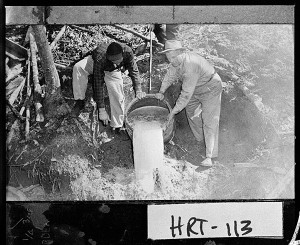And just what is a philatelist you may ask? Not a scientist or doctor of anything, but simply someone who studies stamps! Many Georgia people, events, and symbols have been featured on postage stamps. The man who founded Georgia, James Oglethorpe, was featured on a stamp in 1933–the bicentennial of Oglethorpe’s landing at Yamacraw Bluff to establish the colony of Georgia.
Another Georgia forefather has also been so honored–the man who helped found the University of Georgia, Abraham Baldwin, was featured on a stamp in 1985. Baldwin also played a crucial role in the Constitutional Convention.
Historical events have also been observed on postage stamps, such as Georgia’s ratification of the U.S. Constitution in 1788; this stamp was produced to mark its bicentennial.
More recent events have also been observed. During the 1920s, Franklin D. Roosevelt (an avid philatelist himself) adopted Warm Springs, Georgia as his second home. He even built a cottage there in 1932 that was dubbed the “Little White House”; he died there in April of 1945 while sitting for a portrait. Just four months after Roosevelt passed away, he and the dwelling were featured on a stamp.
Georgia’s state bird and flower, the brown thrasher and the Cherokee rose, were both featured on a stamp in 1982 as part of a set that showcased the state birds and flowers from all fifty states.
Of course, Georgia is renowned as the Peach State (the peach is Georgia’s official state fruit); this was illustrated on a stamp in 1995.
Georgia has a rich literary tradition which has been reflected in stamps. Joel Chandler Harris wrote the Uncle Remus tales. Many of these stories were based upon folktales and folklore shared by local African American storytellers from Turnwold Plantation outside of Eatonton, in Putnam County, where Harris spent much of his youth. Harris was featured on a stamp in 1948.
Sidney Lanier is probably Georgia’s most famous poet; he was portrayed on a stamp in 1972.
And of course one cannot mention Georgia literature without Gone with the Wind and Margaret Mitchell. She was featured on a stamp in 1986.
Georgia has also been home to many famous musicians and songwriters, and some of them have been featured on stamps. Otis Redding sang of leaving his home in Georgia in the song “(Sittin’ On) The Dock of the Bay,” but tragically died in an airplane crash at the age of 26 (in 1968, “(Sittin’ On) The Dock of the Bay” became the first posthumous number one single in American chart history). This commemorative stamp of Otis Redding was issued on June 16, 1993.
Johnny Mercer was born in Savannah and became one of the world’s best-known and most prolific songwriters; among the many hits he composed are “Moon River,””Days of Wine and Roses,” “In the Cool, Cool, Cool of the Evening,” “On the Atchison, Topeka, and the Santa Fe,” “Jeepers Creepers,” “Accentuate the Positive,” “Glow-Worm,” “Goody Goody,” and “Hooray for Hollywood.”
Georgia has also been home to some great sportsmen, sportswomen, and sporting events. Jackie Robinson, the man who broke major league baseball’s color barrier in 1947, was born in Cairo, Georgia. He was featured on a stamp in 1982.
Atlanta and Georgia hosted the Olympic Games in their centennial year of 1996. In that same year the United States Postal Service issue a sheet of stamps commemorating this event.
Many more stamps, postal stationery, and revenue stamps featuring Georgia and Georgians can be seen on the GeorgiaInfo Georgia on Stamps page.


















